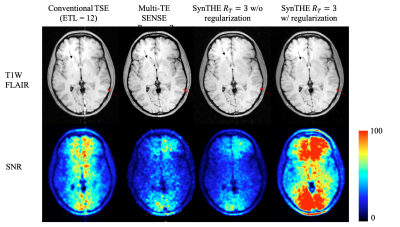Tzu-Cheng Chao1 and James G. Pipe1
1Department of Radiology, Mayo Clinic, Rochester, MN, United States
1Department of Radiology, Mayo Clinic, Rochester, MN, United States
The proposed method reduces blurring in T1W FLAIR. In addition, both T1W and T2W FLAIR can be imaged in a single scan with no additional scan time.

Fig 2. Blurring due to T2 decay can be noticed in the imaging from a conventional scan (red arrow) and is mitigated in both SENSE and Temporal Harmonic Encoding reconstruction despite noise increment. In spite of contrast reduction around basal ganglia, Temporal Harmonic Encoding image retains the gray/white matter contrast in most of the brain. Both SENSE and Temporal Harmonic Encoding demonstrates similar SNR reduction compared to the conventional imaging. On the other hand, the regularization applied on Temporal Harmonic Encoding image restores SNR with improved image quality.

Fig 3. (a) The average of the other two harmonic components in Temporal Harmonic Encoding reconstruction indicates the signal changes with TE. Faster T2 decay region appears brighter in the harmonic image. (b) The inverse of (a) will convert the contrast to resemble a T2W image. (c) The T2 map is calculated from the multi-TE SENSE.
